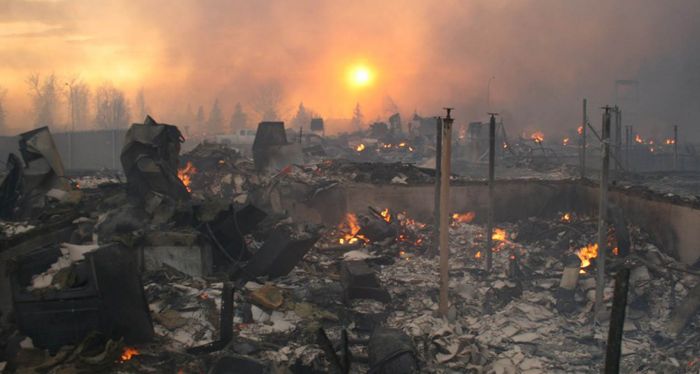So What Does A Business Continuity Plan Actually Look Like?
Views, News & more

Business continuity planning = boring? Well, not really. As you'll well be aware, BCP is an essential part of any organisation’s response planning. And, with you in the driving seat, you might well be the one who gets all the flak if that zombie apocalypse does finally happen and all your firm's IT kit goes up in smoke/gets eaten by zombies/stolen by vagabonds. Granted, we’re thinking of the worst-case scenarios here.
So, in as simple and clear way as possible, we set out the business case for BCP, what a business continuity plan looks like and talk about how you can implement one at work.
Why develop a business continuity strategy?
Investing in a business continuity plan means you can:
- Protect your business against threats like fire, cyber attack, extreme weather (and zombies)
- Protect your staff
- Keep your business running, completing customer orders
- Avoid insurance payouts
- Avoid fines
Business continuity plan template
A disaster recovery plan outlines key procedures for dealing with an emergency, recovering disrupted IT systems and networks, plus details other critical information you might need. Don't have a disaster recovery template? We’ve created one for you. It’s yours, for free!
Identifying threats
Start by identifying what kind of threats your business could face. If you’re a retailer, arson and theft might be higher priority than, say cyber crime, which might apply more to an IT firm. If you live in a flood area, that could be a major priority too. If you live in a major city or in a country with a high terror threat level, you’ll need to consider that too.
Use this table to identify threats and rank them. We’ve included some examples to get you started.
| Potential Threat | Probability | Impact | Actions | |
|---|---|---|---|---|
| Example 1 | Flood | 3/5 | 5/5 | All critical equipment is above ground. Flood recovery plan is in main office. Sandbags are in depot. |
| Example 2 | Cyber Attack | 4/5 | 5/5 | All critical equipment is in room 3 on floor 3. All confidential data is stored in X. |
| Example 3 | Fire | 2/5 | 5/5 | There are sprinklers in our data centre. We have fire and smoke detectors all over the building |
Escalation procedure
Use the impact level you’ve assigned to each threat to develop an according escalation procedure, 1 being low impact, 5 being the highest impact. It could look like this:
- Deal with problem immediately (i.e. clean up a pool of water near a server room).
- Seal off area and notify management.
- Seal off and evacuate specific area. Notify management and emergency services if necessary.
- Complete evacuation of building. Contact emergency services.
- Notify Emergency Response Team. Complete evacuation of building. Contact emergency services. Notify employees’ families.
Setting up an evacuation procedure
In the event of an emergency, your staff will need direction. Use this template.
|
Team |
Assembly point |
|
|---|---|---|
| Example 1 | A |
Underground car park |
| Example 2 |
B |
Pub car park close to office |
| Example 3 | C |
Square over the road |
Contacting employees
Ensure all staff are notified in the event of a disaster – this includes those not working. Give managers or designated employees specific responsibility to contacting staff. When employees can’t be reached, call the person’s emergency contact.
Preparing for the media
If you’re a well-known company or you experience a significant disaster, media work will probably be necessary. Assign someone to handle media enquiries and prepare a short press release that succinctly explains what happened, who is affected and what you are doing to deal with it.
Emergency contact information – internal
It’s a good idea to appoint a set of key people to serve as emergency contacts.
If you need to get hold of someone in an emergency, these people are who you should contact.
|
Name and job title |
Contact method (place an asterisk next to preferred choice) |
Number/address |
|
|---|---|---|---|
| Example 1 |
------ |
Work number |
------ |
| Example 2 |
----- |
Mobile number |
----- |
| Example 3 |
----- |
Home number |
----- |
| Example 4 |
----- |
|
----- |
Emergency contact information – external
If you need to get hold of an external party in an emergency, such as a supplier or power company, these people are who you should contact.
|
Name and job title |
Contact method (place an asterisk next to preferred choice) |
Number/address |
|
|---|---|---|---|
| Example 1 |
------ |
Work number |
------ |
| Example 2 |
----- |
Mobile number |
----- |
| Example 3 |
----- |
Home number |
----- |
| Example 4 |
----- |
|
----- |
Alarm and door codes
If you need to gain access to a protected part of the building or check that an alarm or door code is working, here’s what you need.
|
Door/area |
Code | |
|---|---|---|
| Example 1 |
Server room 3 |
1458 |
| Example 2 |
Plant room |
1569 |
| Example 3 |
Management office |
1478 |
| Example 4 |
CCTV room |
1258 |
We hope this business continuity template will get your disaster response planning off to a great start. Our free, in-depth guide to business continuity supports you in developing a thorough plan, tells you the business threats you need to know about and the immediate steps you can take to reduce your threat exposure. Just pop in your email here to get the free guide.
Get in touch
020 7847 4510
We may process your personal information in order to send you information you request, measure and improve our marketing campaigns, and further our legitimate interests. For further details, see our privacy policy.
Contact us
-
- Head Office:
- hSo, 50 Leman Street, London, E1 8HQ
- Switchboard:
- 020 7847 4500
- Support (24x7):
- 0333 200 3337
- support@hso.co.uk
- Marketing & Sales:
- 020 7847 4510
- info@hso.co.uk

















